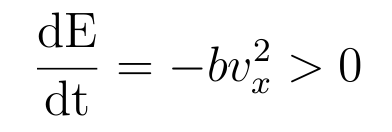| View Texbook |
- Example of the damping is action of the friction force proportional to velocity F = - b vx . Friction coefficient b has dimensionality kg/s and is positive, with friction working against the motion.
- The equation of motion is

- The mechanical energy
 is not conserved, changing
at the rate
is not conserved, changing
at the rate

- leading to a loss of mechanical energy

Weak damping
- We are in the regime of weak damping if b^2 < 4 k m
- In this case damped oscillator is described by

Strong damping
- Strong damping occurs when b^2 > 4 k m
- In this case damped oscillator is described by

- Interesting feature: strongly damped oscillator cannot pass equilibrium point more than once
Critical damping
- Critical damping occurs when the friction is exactly equal critical value b^2 = 4 k m
Forced Oscillations, Resonance
- Consider an oscillator driven from equilibrium by the action of
the periodic force
F = Fmax cos(&omegad t ) - The amplitude the oscillator reaches depends on the
- Amplitude of the driving force F = Fmax
- Frequency of the driving force &omegad
- Natural frequency of the oscillator &omega
- damping b

- The amplitude is highest when the frequency of the driving force is equal
to natural frequency of the oscillator,
i.e when the force is in resonance
&omegad = &omega - In resonance
Ares = Fmax/(b &omegad) Resonance amplitude is formally infinite if there is no damping ! (well in real system it may reach large values before saturation by other effects)
Back